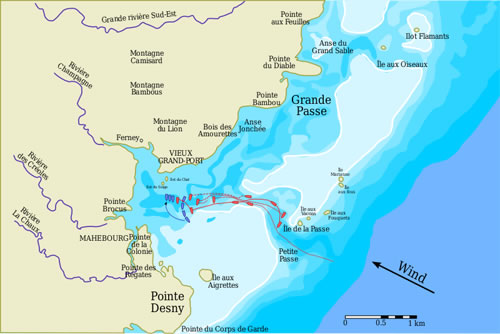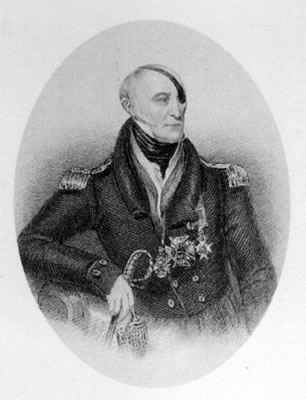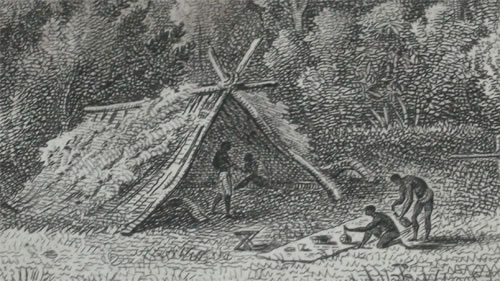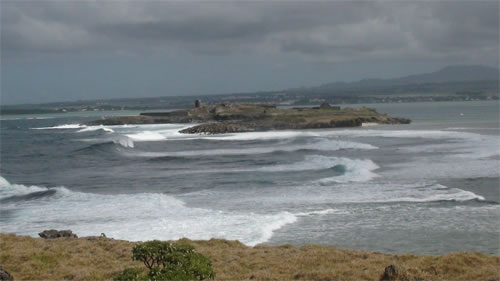PITCH
On the backdrop of the Naval Battle of Grand Port 1810 between French and British over the control of the Indian Oceans, the pregnant slave woman CHIAMAKA, has to take a decision, whether to keep her child, as being conceived by the act of love with colon son Frederic or by the rape by slavedrivers. Is it a child of Love or Violence? This symbolic question is the movie's metapher for the post colonial societies, not only of Mauritius.
LOGLINE
Is History true? Or is humanity living on fiction to build and rebuild her civilization in 2010. 2110. 2210? Mauritius , Naval Battle of Grand Port, 1810. Chiamaka, the mystical Malagasy slave, struggles. Pregnant. Either of her French revolutionary colon lover. Or of the rape by the colon's slavedriver crew. Either a child of love, or a child of hate.
The naval Battle at Grand Port. Under British and French flags, European, Indian and African soldiers fight for the gold of the others. The fat Kings at home. The war which is none, but costs lives. The Sergeant to all captains looses his mind. To find a truth in the blood mixing with the salty waters. Goddess Kali laughs. Who are we? The raw cut of Life is never Fiction. It is always Truth. It is always contemporary. A cinematographic travel through historical and spiritual space by interdisciplinary artist NIKUNJA.
SYNOPSIS SHORT
When VANNEE, the Indian graphic designer of Port Louis dies in a sudden car accident, she travels back through her past incarnations to find herself as CHIAMAKA, the mystical Malagasy slave woman of 1810. With her slave friends , like many others do in these August days, she overlooks from the surrounding hills the bay of Grand Port. Under their eyes, the unfolding Naval Battle of Grand Port confronts Brits and French in their quest for control of the Indian Oceans, main route to travel the stolen Asian treasures to the mouth of the greedy European aristocracy.
Chiamaka suffers from an intimate struggle. She is pregnant. Either from her scandalous relation to French revolutionary colon-lover FREDERIC, murdered. Or by the multiple rape by the set-up punishment expedition, chiefed by slave driver EMANUEL, servant to JEAN FRANCOIX ROUBAIX’ , Frederic’s father.
Taken in the battle between both sides, the Shakespearian sergeant to all captains, WILLOUGHBY, DUPERRE/BOUVET and PIJM, leads us through the karma charged reality of war and the struggle of man, to master his destiny. Meditating on floating bodies, the blood mixing with the salty waters, his madness gives meaning to the meaningless. And Goddess Kali, the world-mother, laughs.
Chiamaka’s struggle to hold the child or not, a child of love OR violence, is reflecting in the ongoing battle, of men, sacrificing lives for the gold of others, for the gain of others, their aristocracies back home. The flashbacks to VANNEE fighting in the hospital a lost battle for survival, posts the question to the modern postcolonial society: are we children of love or hate?
A new look at history, falsified by the winners, confronting the individual and family drama of the protagonists to the geo political issues, which still dominate the world, 200 years later. When we still are made believe, that war is inevitable and just. When still individual lives are mercilessly sacrificed for the interest of a small aristocracy of gold. When still ethnical confrontations are provoked for political issues. Here and Now.
The movie is the proposal for cultural change. In attitude. In behaviour. In the way we look at images of “truth”. For a renewed postcolonial reality of the world, still kept in the shackles of colonisation.
Consequently director and writer NIKUNJA provokes our senses and logic of perception, by a story line and language of image and performance, which make us, the spectator a creative and thus responsible part of the interpretation and perception of the movie, thus history, thus truth. The associative intuition and the intuitive association the movie enables, are they the subjective truth, the only historical truth possible?
A disturbing movie by interdisciplinary artist, writer and award winning French director NIKUNJA. Don’t expect the 0815 script.
|
|
GENERAL INFORMATION
LENGTH 110 minutes
FORMATS
- Caméra 35 mm
- Caméra HD pro
- Camera HD semi pro
- dv amateur
-16mm black and white
PROVISIONAL PRODUCTION/ CO PRODUCTIONS (state 8/10)
ALEFA PRODUCTION REUNION ISLAND/FRANCE
BLACK BUTTERFLY PRODUCTION MAURITIUS
FIREWORX MEDIA JOHANNESBURG, SOUTH AFRCA
PICTURE PERFECT, INDIA
FINANCIAL MANAGEMENT
SYGMADEV CORPORATION, MAURITIUS/REUNION ISLAND France
TECHNICAL /PRODUCTION CAST
DIRECTOR/AUTHOR NIKUNJA
CO AUTHOR DIALOGUES SEETA JEEANAH
DIRECTOR OF PHOTOGRAPHY JEAN MARC SELVAJEAN MARC SELVA SHOWREEL
CHIEF DECORATOR MARC THIEBAULT
HISTORICAL RESEARCH/ADVICE SEETA JEEANAH with the support of the UNIVERSITY OF MAURITIUS, Mr. JOCELYN CHAN LOW and Mrs Dr VIJAYA TEALOCK and the NATIONAL LIBRARY
TECHNICAL DETAILS
3D Animation
Partial reconstruction of boats
Costumes and furniture of historical accuracy
PROVISIONAL TIME TABLE
32 days of preparation with actors
47 days of shooting
8 weeks of post production
final casting MARCH 2010
preparation APRIL/MAI 2012
provisional shooting period JUNE/JULY 2012
AVANT PREMIERE MAURITIUS
December 2012
Local logistics and accommodation is provided by the
CULTURAL MINISTRY OF CULTURE AND EDUCATION, MAURITIUS
PROVISIONAL CAST (except Chiamaka, Thema)
VANNEE/ GODDESS KALI----------NANDANA SEN, INDIA
CAPTAINS WILLOUGHBY, DUPERRE, BOUVET----------THEO TRIFARD, FRANCE
FREDERIC ROUBAIX----------CHRISTOPHE GREGOIRE, FRANCE
NYARAI----------VENANTIA OTTO, SOUTH AFRICA
MISTRESS OF DEATH----------MANNEE JEEANAH, MAURITIUS
NAPOLEON----------MILA LOBOS GARCIA, CHILLI/ FRANCE
JEAN FRANCOIS ROUBAIX----------ROBERT FURLONG, MAURITIUS
OLIVIER ROUBAIX----------DAVID FURLONG, MAURITIUS/UK
CORINNE ROUBAIX----------DELPHINE CHALLIER, MAURITIUS
EMANUEL----------EMMANUEL BRICE KELLY, MAURITIUS
SERGEANT/1ST OFFICER----------ANDREW RENE, MAURITIUS
SOA----------SANDRINE RASHOONAUTH
ACTORS PHOTOS
get additional information
Presse 1 2 3

|
CHIAMAKA, THE BATTLE OF GRAND PORT 1810
Fiction 110minutes, ALEFAPRODUCTIONS, RUN, BLACK BUTTERFLY PRODUCTION, MAU, WRITTEN BY NIKUNJA/JEEANAH, DIRECTED BY NIKUNJA
SYNOPSIS/creation concept
INTRO
The project concentrates on the actual battle as the centre of the events. The battle is a battle between forces, not only the British and French physical armoury forces, but also spiritual forces. Mainly I will interrogate the position of and the point of view of the black slave population of that time in Mauritius, which was of about 66000 people, towards 6500 white colons and 3800 free coloured people.
STORY of CHIAMAKA
The main story is framed by the narration about the young Indian woman VANEE, living in contemporary Mauritius, in Port Louis. The beginning of the movie shows her preparing in the morning to go to work. Taking her car, she has a terrible accident and is going to die. While dying in a visionary state between life and death, she sees her former incarnations and thus joins CHIAMAKA and her story, which is her own previous incarnation. During the whole movie, this contemporary level appears from time to time. There are parallels to her ending contemporary life.
The main character is a young black woman, CHIAMAKA called CHLOE by the colon, who could be of African as well as Indian origins (metisse from Madagascar). She is part of the 10000 people crowd, watching the battle from the hills surrounding the bay. She is accompanied by two girl friends, THEMA, named LOUISE by her colon, JEAN FRANCOIS ROUBAIX, and NYARAI, as well as SOA, a young girl, friend and protégée of Nyarai.
In flash backs during her conversation at the campfire with her friends on a rock above the bay, we will learn about her life circumstances, her strong character inspired by spiritual rituals, her love story to the colons JEAN FRANCOIS’ son FREDERIC, strong defender of the ideals of the French Revolution, the rape by the colon’s JEAN FRANCOIS slave drivers and friends. We learn about CHIAMAKA’s state of early pregnancy and her interrogation about the child, which could have been conceived either from the rape as well as from her love relationship to FREDERIC ROUBAIX.
The battle scenes reflect the inner conflicts of the young woman, who herself struggles for survival in a life of utter hardship. She psychologically floats between the desire to live and the desire to die. The child is a small hope, but of unknown attributes. The desires of possession of the two European forces battling, have little sense and importance for her, as for most of the slave population of that uncertain and hard time, and it does not really matter, who would be winning. However there reigned some hope among the black slave population, that the Britain would liberate them, once in power. This hope is expressed by SOA and NYARAI.
STORY of THE BATTLE
The psychological relations between the individual captains on both sides appear through the various dialogues, and reflect the conflicting forces in CHIAMAKA.
The description of the evolution of the battle mainly follows two specific lines:
- the psychological structure of the individual captains and their relations to each other. It is through their individual subjective experiences we learn about the battle’s evolution. Beyond national interests, the individual aspirations are in the foreground.
- images of paintings, drawings, lithographs etc, by GILBERT and other historic painters, relating to contemporary historic writing through news images, etc GILBERT also appears as a fictional figure in the movie. The historic truth is the result of subjective perception.
The British got support of French royalists. Among them is the pilot of WILLOUGHBY, who was able to lead the Britains through the corals to the port.
The description of the battle and its formulation show the simultaneity of two very different cultural and social perceptions, an African and a European one. Still today these perceptions reign bound by political and economical interests and thus the movie gets a very contemporary attitude.
In addition, the movie communicates realistically on the life circumstances of the Mauritian population of that time, the presence and importance of the Indian and Chinese population on the evolution of this early Mauritian history. The movie valorises the contribution of the different communities, without nostalgia and false pride.
The battle scenes would follow the precise historic descriptions, we learn about the conflict between the two British commanders, about the French strategy, about the British naval troops coming from Saint Paul on Reunion Island under captain PIJM.
An important exchange happens between the two main captains WILLOUGHBY and DUPERRE, when they meet in the bath room, both hurt severely and far from the still ongoing battle.
The movie reflects on the conflict directed by the greed of a royal aristocracy and a French bourgeoisie, guided by Napoleon, willing to abandon the ideals of the French Revolution for the sake of the false comfort and value of a pseudo aristocracy built on the same aspirations for possession and imperialism as the former royalist aristocracy.
STORY of FREDERIC
These thoughts appear through the colon’s son FREDERIC, the lover of CHIAMAKA, who was deeply impressed by the ongoing inhuman behaviour of the local colon society, thus opposing his father. He was a constant critic, also a writer and thinker, and felt attracted to CHIAMAKA and her mysterious beauty, filled with a secret spiritual force.
We learn about the family ROUBAIX through the tellings of THEMA at the campfire, slave servant at the colon’s beautiful house, who describes a family fight during a diner scene, between father JEAN FRANCOIS and FREDERIC.
His relation to CHIAMAKA was not tolerated by the colon’s society and seen as an offence. During a casual meeting at the bar SANS CULOTTES, frequented by colons, their slave drivers, prostitutes, etc, between EMMANUEL, OLIVIER, second son of JEAN FRANCOIS ROUBAIX, and their friends, the dark plan was made, to give FREDERIC a good lesson. After seeing him setting off to the hut of CHIAMAKA, they follow him later on, already heated by the araque and beer, and set fire to the hut of CHIAMAKA, where the couple was sleeping. CHIAMAKA is being captured, drawn to a close by ruins place and raped, while FREDERIC does not escape the fire blast.
Following the murder of her beloved dearest son, his mother CORINNE would leave Mauritius and go back to her family in France.
CONCLUSION
By creating a parallel between the battle scenes and the psychic state of CHIAMAKA/FREDERIC the national context is being questioned and brought into the individual humanistic context. It allows a broader comprehension of that battle in the historic context liberated from occidental ideology and a false 19th Century Napoleon nostalgia. Today the importance must be to enlighten a true look on all circumstances of those times, thus to be able to create unity in the Mauritian society across all communities.
The concluding scene, where we meet CHIAMAKA’S son playing in a contemporary setting, a child which is born from conflicting attributes, but which in itself is a new and innocent being, composed from all these attributes, we are directed to the future reality of the multi cultural societies, born in the conflicting relations of colonialism.
Nikunja2009/10 |
|
BATTLE DIRECTORS STATEMENT
This historic movie is addressed to the psychic reality of the contemporary spectator and audience. The technical means employed interrogate their psychic ways of memory and individual historical identity.
Thus the different shooting formats as well as the performance composition with the various actors are being created from a genuine identification with the artistic content, which is linked to the historic content of the movie. Acting and the presence of artistic performance join in fusion of a new form of expression.
To counter the normal autocratic way of traditional historic writing, usually composed by the dominant in political and social powers, I strengthen the responsibility of the individual by proposing an intuitive language which addresses the psychic reality of the intimacy of the individual spectator beyond racial, religious, social and gender aspects, but nevertheless taking them fully in account.
The shooting formats as well as the rhythmic of time in the editing composition, reflects and interrogates the visual approach of the individual’s eye onto an object and its coloration by his state of perception. Whereas often this process is seen as an educational intellectual one, who enables to broaden the individual’s awareness through an analytical narration, I invoke initiatic images, which own an archetypical language, like often found in the creation of rituals of all cultures and times. It calls on an intuitive supramental plane, which belongs to all human beings as a common plane of consciousness. Not only this, one may call a common human cultural language, but it is also a plane at the very source of human culture. The spectator is offered the opportunity to tap into his own creative potential towards a precise artistic and cultural content.
In the final editorial composition of the movie, I use the interdisciplinary net of what has been created during the shooting of the various sequences to define the interdisciplinary space beyond the individual media. All elements determining sound, performance, image, place, space, time, physical and spiritual volume, are treated simultaneously and in a precise interdisciplinary relation and composition.
To me cinema is the foremost interdisciplinary media, where technique and arts join in a common quest for new forms of human perception in the frame of the Gesamtkunstwerk.
Nikunja 2010

| FRENCH ADMIRAL GUY VICTOR DUPERRE |
|

| BRITISH CAPTAIN NESBIT WILLOUGHBY |
|
|
Thoughts
Towards a historic theme, I take a humanistic approach in putting above the national collective importance of history the individual life circumstances and the psychic reality of the main characters. The psychic reality is at the base of physical reality and there is a constant play going on between the two spheres. I want to make tangible that importance as a contemporary understanding of history, which must be understood as the assembly of individual destiny in a certain context of collective interest. In a just world, that collective interest may not be based on the individual physical or psychic loss.
Using the imaginary world of the main characters as the storyline, allows to reflect about the battle as we would do it for a personal event: we recall the event in images from different angles, we add complementary images and associations and thus create a very personal subjective approach to the event. Each time we remember the same event, we would also have another way of putting values to it. That organic form of memory I would like to oppose to the constructed politically motivated ideologically determined presentation of memory or history.
Nevertheless, the generally known facts of the battle will be present in the movie. But the captains and other protagonists of the battle field will also been shown from a very personal intimate angle. Battle scenes will be presented in a theatrical way, and, referring to the personal state of memory, reframes will be used as projections and/or superposition to describe the happenings on the battle field.
The happenings on the boat, will be described in a house with several rooms, like the house of the psychic of man. Each protagonist has his room in the same house. Each event has a reference in a specific room of the house. Thus we translate the representation of a fact to the presence of a psychic state in the spectator.
The frame story of the young Indian lady from the beginning takes the spectator immediately away from a false historic nostalgia and refers directly to the contemporary Mauritian population, thus also valorising the commemoration of this battle in a contemporary context, what seems very important to me in regards to the common Mauritian identity, as well as the construction of a common identity in all post colonial multi ethnical societies.
Showing that in the context of the process of reincarnation (being a strong value in Indian philosophy) as an Indian one could well have had a creolian past or future incarnation, we put the question of racism in a new context. If a population is very much defined by communities that keep their homogeny strict forms and define themselves opposite the other, a latent racism is always present. So this movie may contribute for a broader understanding based on an Indian philosophical point of view, which personally I find very important in regards to the Mauritian history. |
|
Director’s statement
Coming from painting and visual arts I take a new approach to cinematographic work. The materiality of the format in which we shoot in, lets say 35mm, different HD formats, dv formats, etc I use as a psychic texture in the formulation of the cinema work, as you would use different textures in painting for expression. This materiality does not have to appear in a “narrative logic” as it is seen commonly in new cinema, but as a value of expression in itself. I give a texture to the movie surface and compose it as a significant structure in regards to the artistic content of the movie.
In a similar way I treat the quality of performance. Working also in art performances, contemporary dance, ritual performance, I use those “performance materials” as textures, confronting the regular acting, and touching a level of authenticity, which otherwise hardly appears. This approach demands an extensive preparation with the individual actors and a precise choice during casting, which is not merely focussed on the acting performance but on the psychic structure of the personality of the candidate. This preparation is very individual and then directed to the important aspects of the character.
During the actual shooting phase, there are rarely scenes being shot twice or more times. I work in performance sequences, to which the participating actors are prepared, so that they know precisely the content to achieve but keep a free approach to the interpretation of that aspect. It is very performative and the actors are forced to be totally integrated in the sequence, for there are no two takes. Everything is being shot with several cameras at the same time and with several formats at the same time.
The editor phase of the creation process becomes a very exciting phase, for here I can finally compose the movie, in the sense like a painting in multiple layers. This creates an approach to representation, which allows to the spectator to choose different angles of views and to become a creative element while watching. I try to give an authority to the spectator, basically an authority of choice. The hypnotic power of the projected image, sometimes I would break, so that another rhythmical sensation can take place and the spectator finds himself for a moment, giving him a chance to situate himself inside of his own psychic cinematographic experience. Thus the time factor is very important in the editing phase.
By these means I am creating a new cinematographic language which is dense, but also direct and simple in the sense, that it approaches the psychic sensations and later only the intellectual plane. To me it is important to create an art piece, which can communicate to anyone, of any origin, at a mere human level.
Nikunja
|



